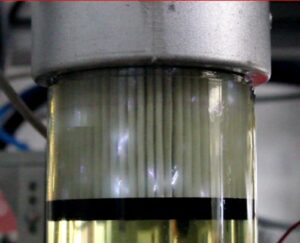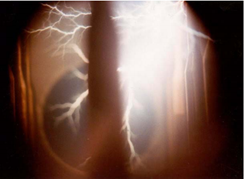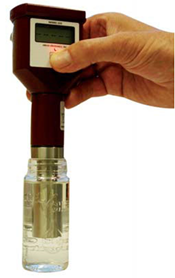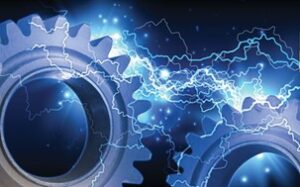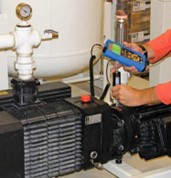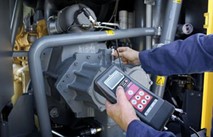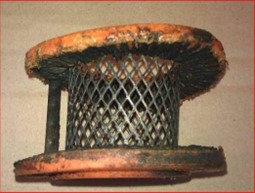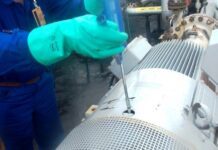
Marcos Thadeu Lobo
Mechanical Engineer Graduated from the State University of Campinas (Unicamp). He is currently an Associate Consultant at QU4TTUOR CONSULTORIA.
Discharges in lubrication systems
Discharges in lubrication systems – The simplest method of checking whether there are problems with electrostatic discharges (sparking) is simply by listening for popping or clicking sounds in the region close to the filter or lubricating oil reservoir. Obviously, a proactive attitude towards electrostatic charges is very important in order to seek to eliminate the source of the problem before trying to solve the damage caused by them.
Figures 1/2 – Electrostatic discharges (sparking) in filter and lubricating oil reservoir.
Many formulators use base oils from Group II and even, in special cases, base oils from Group III in the elaboration of lubricating oils for hydraulic, steam or Natural Gas turbines.
Due to the severe refining processes, the aforementioned types of lubricating oils have very low levels of Electrical Conductivity. It is important to bear in mind that as the Electrical Conductivity of lubricating oils decreases, the potential for arcing increases. Electrical charges arise from friction between lubricating oil molecules as well as between lubricating oil molecules and the surfaces of pipes, lubricating oil reservoirs, lubricating oil filter housings, etc.
 Figure 3 – Electrostatic charge formation process
Figure 3 – Electrostatic charge formation process
Among the factors that contribute to the formation of electrostatic charges in lubricating oils we can mention:
- Insufficient diameter of pipes for the ideal flow of lubricating oil in a centralized oil lubrication system, which causes high flow rates.
- Tracing of pipelines with sudden changes in direction and increased speed of lubricating oil flow.
- Absence of polar additives in the lubricating oil formulation.
- Poor grounding of the mechanical system.
- Low lubricating oil level.
- Air entrainment in lubricating oil.
- The need for lubricating oils with a better General Cleanliness Level, which leads to the need to intensify the lubricating oil filtration operations.
- Type and polarity of base oils and additives.
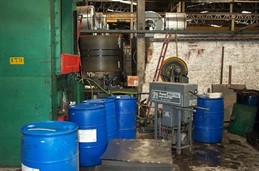
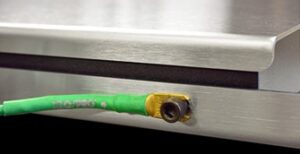 Figures 4/5 – Frequent filtration and poor grounding: some of the reasons for the formation of electrostatic charges.
Figures 4/5 – Frequent filtration and poor grounding: some of the reasons for the formation of electrostatic charges.
Some laboratory tests can be carried out to verify the Electrical Conductivity of lubricating oils. The ASTM D2624-02 test method (Standard Test Methods For Electrical Conductivity Of Aviation And Distillate Fuels), for example, was developed primarily for use in aviation fuels, but has also proven to be very efficient for use in oils lubricants.
Figures 8/9 – Ultrasound and vibration analysis techniques for monitoring electrostatic discharges.
Electrical Conductivity in lubricating oils is measured in Picosiemens per meter (pS/m). As a reference, we can mention that 01 pS/m is equivalent to 10 ohm – 12 ohm. Studies have shown that if the Electrical Conductivity of a lubricating oil is greater than 400 pS/m at 20ºC, the risk of electrostatic discharge will be small. It is also possible to monitor the occurrence of sparking using ultrasound and vibration analysis techniques.
Figures 8/9 – Ultrasound and vibration analysis techniques for monitoring electrostatic discharges.
The aforementioned electrostatic discharge monitoring techniques offer several advantages but, as mentioned earlier, the best way to deal with the matter is by adopting proactive measures with a view to solving the root cause of the problem.
Appropriate lubricating oil filters, changes in the diameters and layout of piping in centralized oil systems or changes in the lubricating oil formulation can help minimize the potential charge or even prevent electrostatic discharges from occurring.
Figures 10 and 11 – Explosion in the lubricating oil reservoir and hole in the filtering element caused by electrostatic discharge.
By controlling the Electrical Conductivity of lubricating oils, it is possible to prevent the formation of electrostatic discharges, thus eliminating the need to detect them.




